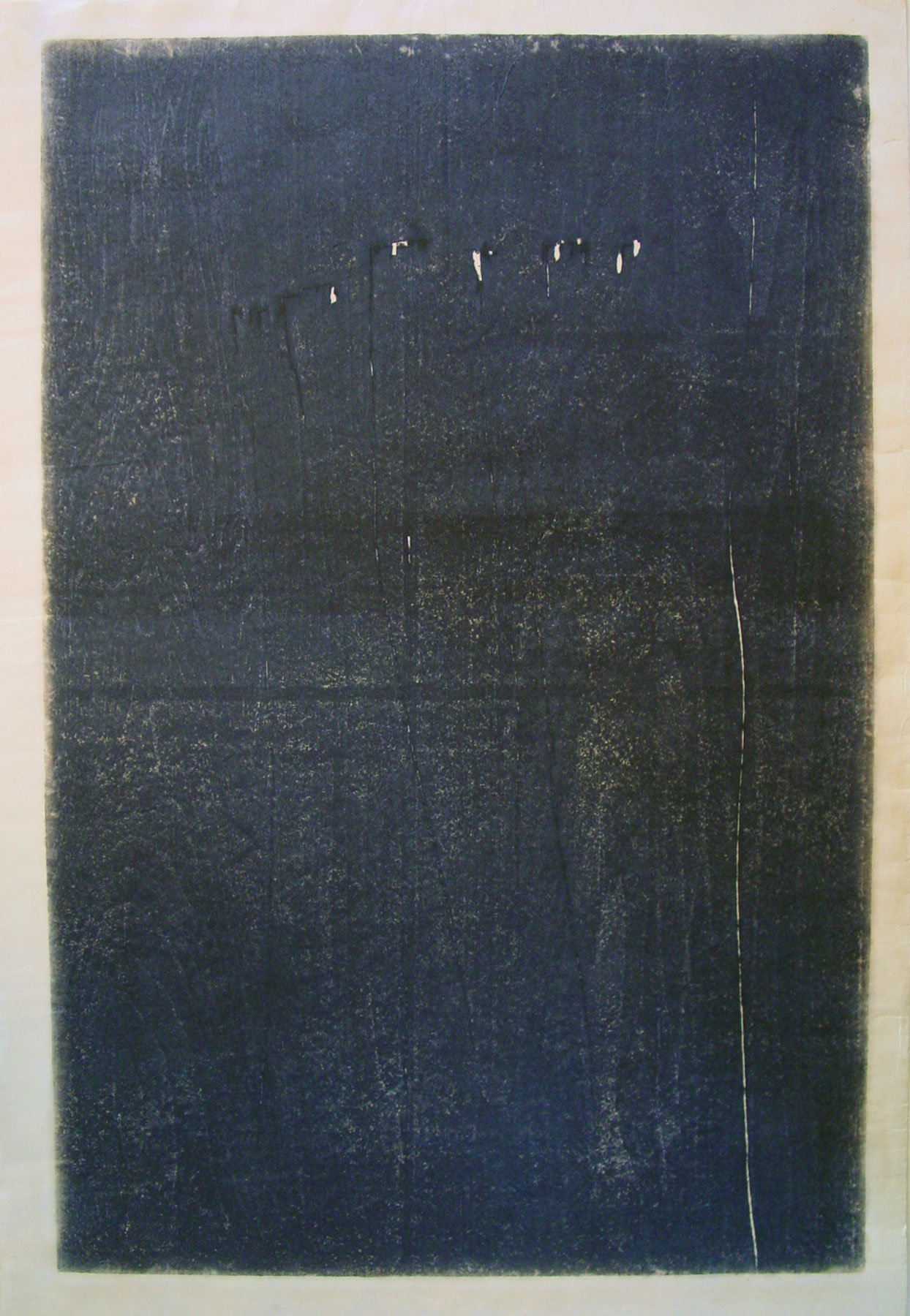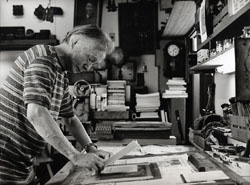Prints in Collection
IHL Cat. #1898
Composition F, c. 1959
IHL Cat. #2148
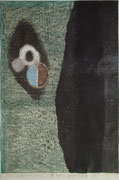 IHL Cat. #395 | 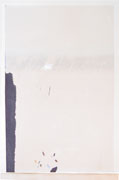 Stone flower: white, 1960 Stone flower: white, 1960IHL Cat. #236 | Stone flower: white, yellow, 1960 IHL Cat. #229 |
Little Pond, 1962 IHL Cat. #348 | A Man in Armor (17), 1963 IHL Cat. #1765 |
IHL Cat. #1117 | IHL Cat. #1030 | 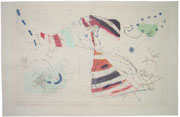 Circus No. 7, 1968 IHL Cat. #182 |
 Clown No. 5, 1969 Clown No. 5, 1969IHL Cat. #387 | 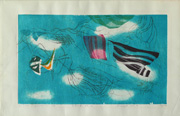 Breeze No. 2, 1969 IHL Cat. #956 |  ihl1862 thumb web.jpg) Lady (B), 1970 IHL Cat. #1862 |
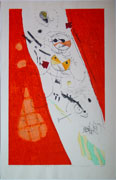 Flying angel No. 3, 1970 Flying angel No. 3, 1970 IHL Cat. #318 | IHL Cat. #559 | 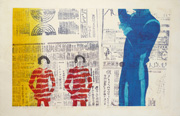 Shadow No. 12, 1972 IHL Cat. #560 |
Glass Festival ガラスの祭典, 1998
IHL Cat. #1689
Biographical Data
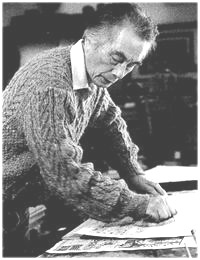 Hideo Hagiwara (1986) | ProfileHagiwara Hideo (1913-2007) Sources: Collecting Modern Japanese Prints, Then and Now, Mary and Norman Tolman, Charles E. Tuttle Company, 1994 and Modern Japanese Prints 1912-1989, Lawrence Smith, British Museum Press, 1994, p. 23.Hideo Hagiwara is a master of the Japanese contemporary woodblock printing technique and one of the best known Japanese artists of the 20th century. While he employs a broad variety of printmaking techniques including woodblock, lithograph, etching and stencil, he is best known for his woodblock prints. Born in Kofu City, Yamanishi Prefecture in 1913, Hideo Hagiwara lived in Korea and Manchuria during his early years. After returning to Japan in 1929 he studied oil painting at the Tokyo School of Fine Arts from which he graduated in 1938. While in school he briefly studied woodblock printing with Hiratsuka Un'ichi (1895-1997), a major figure in the sosaku hanga (creative print) movement. He spent the first 20 years of his career as a painter (and continued to paint throughout his career), but during his recuperation from tuberculosis (1953-1955) he took up woodblock printing. In 1958 he began to explore abstraction and began employing innovative and experimental printmaking techniques. His work began to receive international acclaim in the 1960s with numerous international exhibitions. Hagiwara served as Chairman of the Japanese Print Association for many years and in 1989 he was awarded a gold medal by the Nobel Prize Committee for five works produced on themes from the novels of Kawabata Yasunari. He passed away on November 4, 2007 at the age of 94. |
Biography
Hagiwara Hideo (1913-2007) 萩原英雄Sources: International Fine Print Dealers website http://www.ifpda.org/content/node/967; 44 Modern Japanese Print Artists, Gaston Petit, Kodansha International Ltd., 1973, vol. I, p. 112; Contemporary Printmaking in Japan, Ronald G. Robertson, Crown Publishers Inc., 1965, p. 68-69; Modern Japanese Prints 1912-1989, Lawrence Smith, British Museum Press, 1994, p. 23; Collecting Modern Japanese Prints Then & Now, Mary & Norman Tolman, Charles E. Tuttle Publishing Co., Inc, 1994 and as footnoted.
Born in Kofu City, Yamanashi Prefecture in 1913, little has been written about Hagiwara's early years other than having spent them in Korea and Manchuria as his father was posted to these spots performing police duties. In 1929, he was sent back to Japan and, in preparation for entering the Tokyo School of Fine Arts, studied under the painter Mimino Usaburo (1891-1974). While at the Fine Arts school it is reported (Lawrence Smith in "Modern Japanese Prints 1912-1989") that Hagiwara took an extra-curricular woodblock printing course with Hiratsuka Un'ichi (1895-1997), a seminal figure in the sosaku hanga (creative print) movement. After graduation from the oil painting department of the Tokyo School of Fine Arts in 1938, Hagiwara joined the Takamizawa Woodcut Company which specialized in copying ukiyo-e prints. He did not engage in making prints himself, however; his task was to compare the works executed by artisans with the original, controlling accuracy and having the necessary corrections made. He was conscripted into the army in 1943, working as an "army coolie,"1 and returned to Tokyo in 1945 to find his house and studio in ruins and most of his early works destroyed as a result of the U.S. air raids. During his recuperation from tuberculosis (1953-55) he began making woodcuts for greeting cards and printed his first New Year’s cards, which were well received and brought woodblock printing into his oeuvre. His first print exhibition in 1956 at Tokyo's Yoseido Gallery consisted of figurative works, and 1958 marked the artist’s first showing of abstract prints, which were to bring him international acclaim.
Hagiwara taught at the University of Oregon in 1967 as a guest professor. In 1977 he became a lecturer at the Tokyo University of Fine Arts and Music and in 1979 he became Chairman of the Japanese Print Association, a position he held for many years.
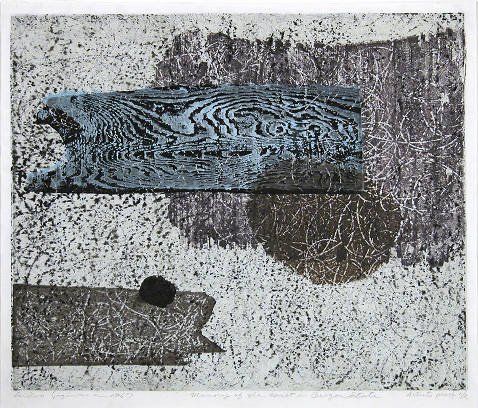
Memory of the Coast of Oregon State, 1967
© Hagiwara Hideo
In 1983 he was awarded the “Purple Ribbon” by the Japanese government for his devotion to the development of the Japanese art. In 1989 he was awarded a gold medal by the Nobel Prize Committee for five works produced on themes from the novels of Kawabata Yasunari.
1 “New Shapes in Old Wood,” Time Magazine, September 07, 1959.
The Artist at Home
Source: Japanese Prints Today: Tradition with Innovation, Margaret K. Johnson, Dale K. Hilton, Shufunotomo Co., Ltd., 1980, p. 82To visit Hagiwara is to become aware of some of the sources that stir his inspiration. Art objects and artifacts of man's long history are carefully chosen to embellish the living and working spaces. These objects span much time and geography with a common quality of genuineness, directness, perhaps humbleness - a sort of primitive, of-the-earth sophistication with meaning for all time.
Among his interests are the pots created more than 4,000 years ago during Japan's Jomon Period. These pots represent Japan's earliest artistic achievements. They belie their ancient origin in the fresh treatment of the clay. There are scratchings, impressions from ropes, and thin rolls and globs of clay pressed onto the clay body, similar to contemporary techniques that feature the natural characteristics of clay.
One can appreciate Hagiwara's interest in such examples, where clay, hand, and tool work in natural harmony. His own work reveals a similar harmony of wood, hand, and tool. The influence on Hagiwara's work from Jomon pots and other artistic achievements of man's past has been strong, but indirect. Hagiwara tells us he does not borrow style or imagery. Rather, he absorbs the atmosphere of these creations, appreciating their directness, their natural use of material and tool, integrity of form, and use of scale and space.
Working in Series
Source: 44 Modern Japanese Print Artists, Gaston Petit, Kodansha International Ltd., 1973, vol. I, p. 112As with so many other woodblock print artists, Hagiwara has worked in series. In addition to being an excellent point of reference for classification, a series is useful in grouping styles and even more interesting when studying one particular style. This prolific artist made more than twenty-two different prints for the Soil series, fifteen for the Stone Flower series, and twelve for the Fantasy series, with an average of twelve prints each for the next nine series. Prints from the Stone Flower series were shown at the second International Tokyo Print Biennale in 1960 which secured his reputation as a leading print artist.
Selected Examples from Individual Print Series
(all images © Hagiwara Hideo) Man in Armor Series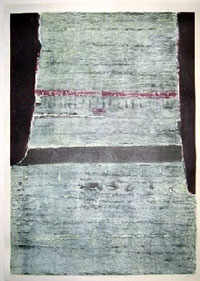 | Fantasy Series | Greek Mythology Series (Lithographic Prints) 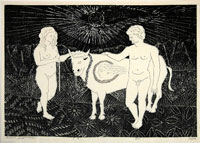 |
Fairyland Series 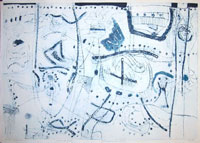 | Circus Series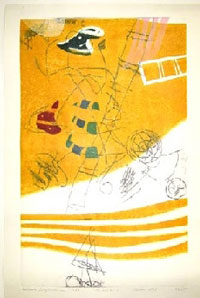 | Shadow Series Shadow No. 12, 1972 IHL Cat. #560 |
Face Series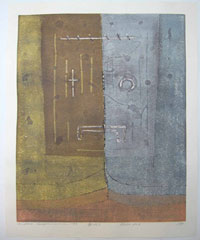 | Ancient Record Series 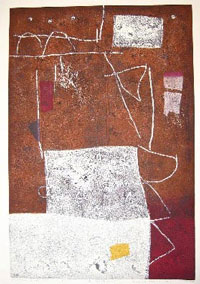 |
Thirty-Six Views of Fuji Series, 1981-1986 - Four Images
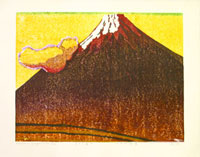 Kenkyō kinshū |  Sora Moeru |
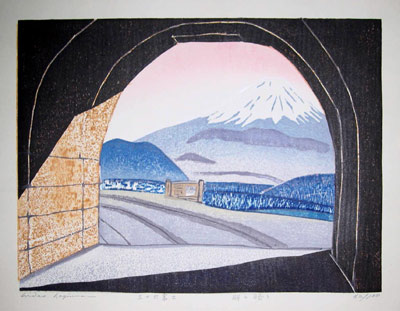 Mei to an to |  Biru no tanima ni |
Innovative Woodblock Techniques
Source: Contemporary Printmaking in Japan, Ronald G. Robertson, Crown Publishers, Inc., 1965, p. 68Hagiwara is always making efforts to find new materials, new tools. He seeks constantly to develop new techniques to augment the many traditional ukiyo-e methods he now uses. His approach is not haphazard or accidental but the result of study and research. He insists that “One must know, rather than rely on the accidental. Accidents are important, but one must catch, analyze, reconstruct, and utilize things found accidentally. The value lies in the reconstruction and consequent predictability in the printing process. One must never forget that the print must be reproduced and that, therefore, the process must be predictable.” And then he adds, “It is the small touches –the details with tools, the modeling of the surface of the block – that count.”
Source: Japanese Prints Today: Tradition with innovation, Margaret K. Johnson, Dale K. Hilton, Shufunotomo Co., Ltd., 1980, p. 80
Hideo Hagiwara deserves a special place in Japan's history of contemporary printmaking, for his intensive exploration of the creative possibilities of woodblock, and for the outstanding prints resulting from this effort. Hagiwara has expanded the potential of the woodblock not only by his own inventive techniques, radical to customary approaches, but also by careful examination of the traditional approaches where he has discovered previously untapped resources. He has skillfully adapted these to serve his expressive needs.
Source: Website of the Freer/Sackler The Smithsonian's Museums of Asian Art http://www.asia.si.edu/collections/singleObject.cfm?ObjectNumber=S1987.1036
Hagiwara's expansion of the limits of woodblock printing through technical innovation was inspired by his admiration for the achievements of potters of the Jomon culture in Japan (10,000–ca. 300 B.C.E.). Studying the complex designs produced by the ancient artisans, Hagiwara sought to understand their mastery of material and technique.
Growing tired of the established form of woodblock printing Hideo Hagiwara began to attach the wood shavings from the cutting process upon the woodblock itself, opening up the expressions of this medium to new limits.
Hagiwara uses no preliminary drawing but sketches lines directly on the block to indicate the basic motif or form. While intuitive, his approach suggests much previous thought and experimentation. He knows and predicts technical details and has the image he wants clearly in mind, working out the form on the block directly and spontaneously.
Source: Japanese Prints Today: Tradition with Innovation Margaret K. Johnson, Dale K. Hilton, Shufunotomo Co., Ltd., 1980, p. 82
To begin his own creations, Hagiwara first visualizes an idea mentally and then carves directly and spontaneously into a plywood block without preliminary sketches. He will use any tool he can find, or make, that will help him express what he wants to say.
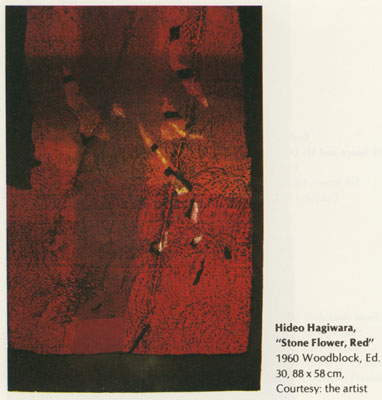
Some of the artist's compositions actually depend for much of their imagery on the baren markings which swirl their way over the surface of the paper. These markings have come through to the back, and the back becomes the featured side of the print. The black circular lines in "Stone Flower, Red" show the rhythms of the baren movements across the work.
Once Hagiwara has worked out the inking requirements for a particular print, the actual inking process for each print of an edition requires its share of time and physical energy. Hagiwara prints his own editions. The print, "Stone Flower, Red" was made from three woodblocks: one for each of the colors - orange, red-yellow and purple. Among these blocks there were twenty inkings, which means twenty layers of ink on each print. The time for inking each print of the edition: two hours.
Artist Quote - The Old is the New
Source: Japanese Prints Today: Tradition with Innovation, Margaret K. Johnson, Dale K. Hilton, Shufunotomo Co., Ltd., 1980, p. 80,81.
The Library of Congress has been collecting Hagiwara's work since the 1950s.
Hideo Hagiwara Collection Room at the Yamanashi Prefectural Museum
Source: http://www.art-museum.pref.yamanashi.jp/english/files/information/leafe.pdf
Reverse Printing
| Source: 44 Modern Japanese Print Artists, Gaston Petit, Kodansha International Ltd., 1973, vol. I, p. 112 It was with the Soil series that he devised a new technique: printing the paper on both sides. Forcing the pigment through the paper, he actually dyed the paper from the back, producing a textural surface on which to work. One feels the unity between picture and paper through the integrated layers of penetration and depth. This technique was used by Hagiwara in the renowned Stone Flower series, a corpus of work which notably enhanced the prestige of Japan in the contemporary print world. Source: Images of a Changing World: Japanese Prints ofthe Twentieth Century, Donald Jenkins, Portland Art Museum, 1983, p.121 In many of his woodblocks, Hagiwara prints the reverse side of the paper first, using an uncut piece of plywood fully inked with water-base dark blues and grays. While the paper is still on the ink-charged solid block, he applies his baren with enough pressure to bring the color to the surface of the paper as a soft patina. Over this texture, he will then print from additional blocks in the traditional way. 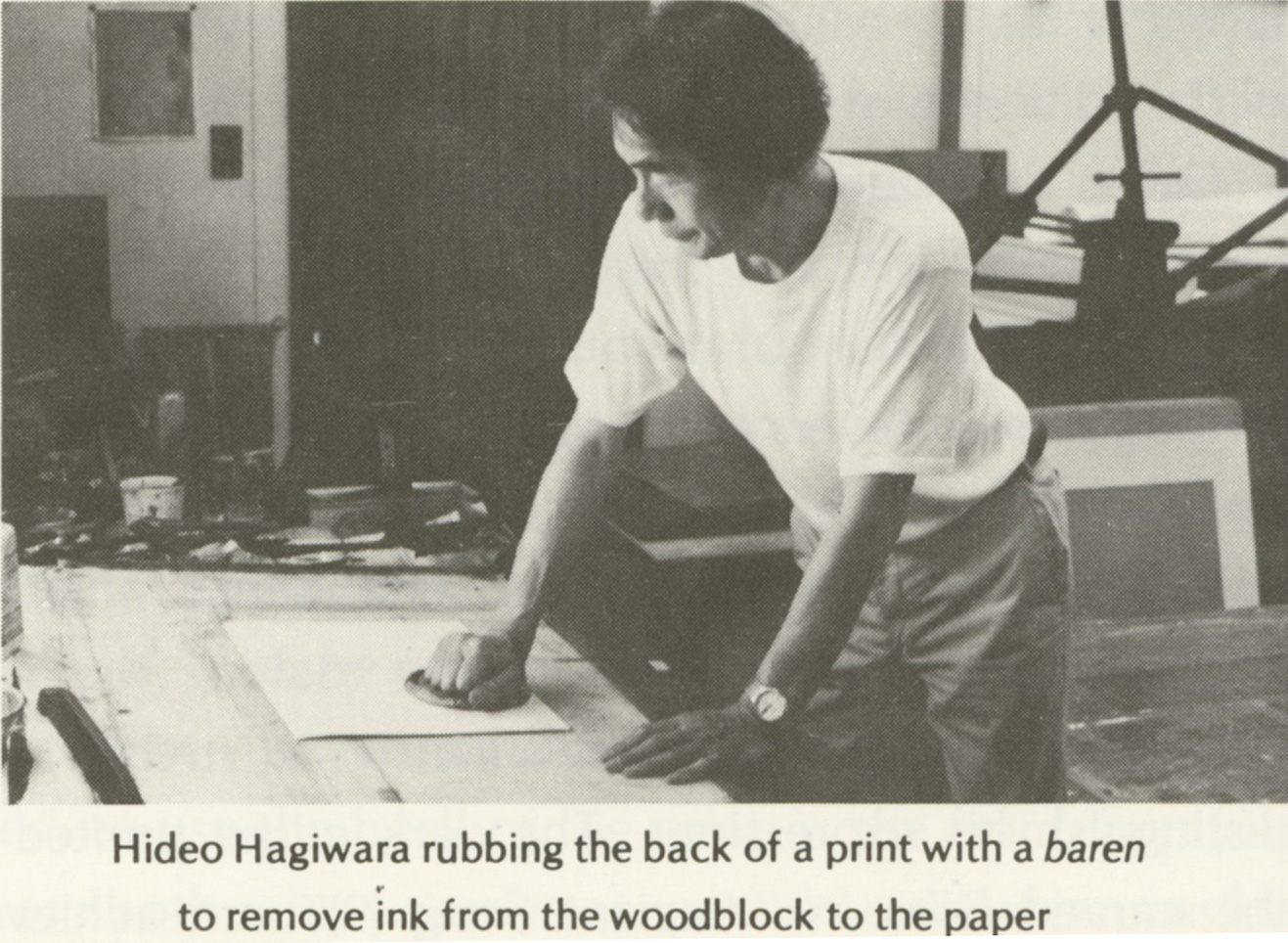 |
Intaglio Simulation
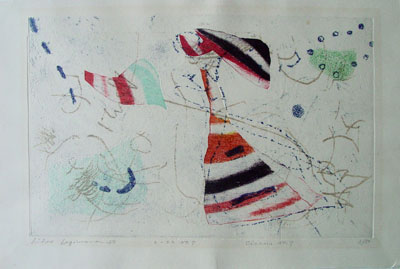 | Source: Images of a Changing World: Japanese Prints of the Twentieth Century, Donald Jenkins, Portland Art Museum, 1983, p. 121. Hagiwara has simulated an etched-line look in many of his prints, such as "Circus No. 7" (left) in this collection. He achieves this effect by scratching lines into his woodblocks with large sharpened nails or spikes. He inks the blocks with water-base colors, then gently wipes the color off the surface as in intaglio plate printmaking, and, with full baren pressure on the back side of the paper, lifts sufficient color from the lines to create an etched effect. |
Carving Directly to Block
Source: Contemporary Printmaking in Japan, Ronald G. Robertson, Crown Publishers, Inc., 1965, p. 66Hagiwara uses no preliminary drawing but sketches lines directly on the block to indicate the basic motif or form. While intuitive, his approach suggests much previous thought and experimentation. He knows and predicts technical details and has the image he wants clearly in mind, working out the form on the block directly and spontaneously.
Source: Japanese Prints Today: Tradition with Innovation Margaret K. Johnson, Dale K. Hilton, Shufunotomo Co., Ltd., 1980, p. 82
To begin his own creations, Hagiwara first visualizes an idea mentally and then carves directly and spontaneously into a plywood block without preliminary sketches. He will use any tool he can find, or make, that will help him express what he wants to say.
An Example in Technique - "Stone Flower, Red"
Source: Japanese Prints Today: Tradition with Innovation, Margaret K. Johnson, Dale K. Hilton, Shufunotomo Co.,Ltd., 1980, p. 89
Some of the artist's compositions actually depend for much of their imagery on the baren markings which swirl their way over the surface of the paper. These markings have come through to the back, and the back becomes the featured side of the print. The black circular lines in "Stone Flower, Red" show the rhythms of the baren movements across the work.
Once Hagiwara has worked out the inking requirements for a particular print, the actual inking process for each print of an edition requires its share of time and physical energy. Hagiwara prints his own editions. The print, "Stone Flower, Red" was made from three woodblocks: one for each of the colors - orange, red-yellow and purple. Among these blocks there were twenty inkings, which means twenty layers of ink on each print. The time for inking each print of the edition: two hours.
Artist Quote - The Old is the New
Source: Japanese Prints Today: Tradition with Innovation, Margaret K. Johnson, Dale K. Hilton, Shufunotomo Co., Ltd., 1980, p. 80,81.
"From the beginning of mankind's history, the thing that flows at the bottom of the human heart is unchangeable. There is no such thing which can be called a new thing or old thing. A spiritually genuine thing is always new, at any time or any age. It is always surprising for me to find the new in old things."
- Hideo Hagiwara
Hagiwara's patient search for the fullest means of visually expressing his thoughts has spanned more than two decades. Among the prints that have resulted over this period, there are monuments: monuments to the universality of man's thoughts, and monuments to the ability of an individual to communicate to the outside world his inner thoughts through his own form of visual expression. That Hagiwara's prints convey their personal message in universal terms is borne out by well-deserved international acclaim.
Students
Among the students of Hagiwara are the Oregon print artist Yūji Hiratsuka and the mezzotint artist Takeshi Katori. Paul Gunn, professor emeritus at Oregon State University, studied with Hagiwara and later brought Hagiwara to OSU to do workshops with students.Collections
Tokyo National Museum of Modern Art; Prefectural Museums of Miyagi, Tochigi, Yamanashi, Wakayama, Oita, Toyama, Hiroshima, and Tokushima; Kamakura Museum of Modern Art; Honolulu Academy of Arts; Art Institute of Chicago; Carnegie Museum of Art; National Gallery of Art; New York Public Library; Boston Museum of Fine Arts; Cincinnati Art Museum; Library of Congress, Washington, D.C.; Rockefeller Foundation, New York; Victoria and Albert Museum, London; Amsterdam Museum of Art; Sao Paulo Museum of Modern Art; Ljubljana, Rijeka, Scopjye, Krakow, Vienna, and Dresden Museums of Modern Art; National Gallery of AustraliaThe Library of Congress has been collecting Hagiwara's work since the 1950s.
Hideo Hagiwara Collection Room at the Yamanashi Prefectural Museum
Source: http://www.art-museum.pref.yamanashi.jp/english/files/information/leafe.pdfHagiwara’s work is housed in a special collection at The Yamanashi Prefectural Museum in Japan.
In 2000, Hideo Hagiwara, an internationally known artist, donated to the Museum his own collection of more than 4000 works. You would enjoy this collection, which ranges from Japanese prehistoric pottery to contemporary prints, as well as his own works, in Hagiwara Hideo Collection Room, which opens in November 2004.
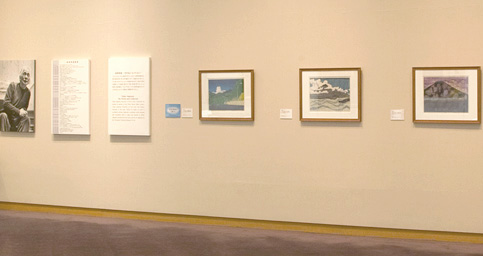
Hideo Hagiwara - Mount Fuji Woodblock Prints, 2006
Source: Institute of East Asian Studies, University of California, Berkeley website http://ieas.berkeley.edu/events/2006.03.27.html
INSTITUTE FOR EAST ASIAN STUDIES through May 19, 2006
This exhibit highlights prints from Hideo Hagiwara’s ‘Thirty-six Fujis’ (Sanju-roku Fuji) series. Hagiwara, who has a house near Mount Fuji, and thus was able to observe the mountain during different seasons and times of the day, produced the series between 1977 and 1986, continuing a long tradition of representations of this famous mountain.
Hideo Hagiwara is one of the most distinguished woodblock print artists in Japan today. During the course of his long career he has exhibited all over the world and has won numerous prizes. His prints are held by major museums in Japan, the US and Europe, including the Museum of Modern Art, New York; the Art Institute, Chicago; the Victoria and Albert Museum in London; and the Vienna National Museum of Art.
KICHIJOJI ART MUSEUM From 2008-09-25 To 2008-11-02
This retrospective exhibition commemorates his passing, and is held at the main gallery space of the museum as well as the Hideo Hagiwara Memorial Museum. This exhibition was made possible through the support of the Yamanashi Prefectural Museum as well as his family and friends. In addition to his woodblock prints, oil, watercolor, and sumi ink paintings as well as collages are on view at this exhibition.
Born in Kofu, Yamanashi in 1913, Hideo Hagiwara studied oil painting at Tokyo Bijutsu Gakko (current Tokyo University of the Arts) starting in1933 and thereafter pursued a career as a painter. In 1953, he became ill and had to spend a period of time in bed. At the end of the year, he made new year's postcards using woodblock printmaking methods. Since then, printmaking grew to become part of his practice, and he created new year's postcards in this way every year for over half a century.
Later, he received a number of awards at various international print exhibitions, and established his career internationally. As a representative printmaker of the postwar era, he continued his practice but passed away last year on November 4th, at the age of 94.
Musashino City holds around 550 works by Hagiwara. Many of them were donated by the artist himself, and helped form a major collection of the city.
In 2000, Hideo Hagiwara, an internationally known artist, donated to the Museum his own collection of more than 4000 works. You would enjoy this collection, which ranges from Japanese prehistoric pottery to contemporary prints, as well as his own works, in Hagiwara Hideo Collection Room, which opens in November 2004.

Recent Exhibitions
Source: Portland Art Museum, Portland, Oregon https://portlandartmuseum.org/exhibitions/three-masters-of-abstraction/
This exhibition presents nearly fifty prints by three Japanese artists who rose to international prominence in the decades following World War II. All of them embraced abstraction, that most quintessential of Western modernisms, as a means for expressing fundamentally Japanese themes.
Hagiwara Hideo (1913–2007) combined abstract expression with imaginative approaches to traditional Japanese woodblock techniques to create prints of great visual depth. Winner of multiple international print exhibition prizes, Hagiwara taught printmaking at Oregon State University in 1967.
Takahashi Rikio (1917–1998) is known for his prints evoking Japanese gardens throughout the seasons, without ever depicting a plant or stone. Working almost exclusively in woodblock, he created images that convey stillness, balance, and a sense of timelessness.
Ida Shōichi (1941–2006) took abstraction to radically new levels. For him, the techniques of silkscreen, lithography, etching, and traditional woodblock printing were not instruments for creating images, but forces that act upon or emerge from the paper. In his reverence for the potential inherent in the materials, Ida harks back to aesthetic values of the Japanese tea ceremony and Mingei movement.
This exhibition draws upon prints in the Museum’s collection and from the Lavenberg Collection of Japanese Prints.
Organized by the Portland Art Museum and curated by Maribeth Graybill, The Arlene and Harold Schnitzer Curator of Asian Art, with Irwin Lavenberg, Research Associate for Japanese Art.
Hideo Hagiwara - Mount Fuji Woodblock Prints, 2006
Source: Institute of East Asian Studies, University of California, Berkeley website http://ieas.berkeley.edu/events/2006.03.27.htmlINSTITUTE FOR EAST ASIAN STUDIES through May 19, 2006
This exhibit highlights prints from Hideo Hagiwara’s ‘Thirty-six Fujis’ (Sanju-roku Fuji) series. Hagiwara, who has a house near Mount Fuji, and thus was able to observe the mountain during different seasons and times of the day, produced the series between 1977 and 1986, continuing a long tradition of representations of this famous mountain.
Hideo Hagiwara is one of the most distinguished woodblock print artists in Japan today. During the course of his long career he has exhibited all over the world and has won numerous prizes. His prints are held by major museums in Japan, the US and Europe, including the Museum of Modern Art, New York; the Art Institute, Chicago; the Victoria and Albert Museum in London; and the Vienna National Museum of Art.
"Mourning Hideo Hagiwara - Pilgrimage of Beauty" Exhibition
Source: Tokyo Artbeat website http://www.tokyoartbeat.com/event/2008/82E6.enKICHIJOJI ART MUSEUM From 2008-09-25 To 2008-11-02
This retrospective exhibition commemorates his passing, and is held at the main gallery space of the museum as well as the Hideo Hagiwara Memorial Museum. This exhibition was made possible through the support of the Yamanashi Prefectural Museum as well as his family and friends. In addition to his woodblock prints, oil, watercolor, and sumi ink paintings as well as collages are on view at this exhibition.
Born in Kofu, Yamanashi in 1913, Hideo Hagiwara studied oil painting at Tokyo Bijutsu Gakko (current Tokyo University of the Arts) starting in1933 and thereafter pursued a career as a painter. In 1953, he became ill and had to spend a period of time in bed. At the end of the year, he made new year's postcards using woodblock printmaking methods. Since then, printmaking grew to become part of his practice, and he created new year's postcards in this way every year for over half a century.
Later, he received a number of awards at various international print exhibitions, and established his career internationally. As a representative printmaker of the postwar era, he continued his practice but passed away last year on November 4th, at the age of 94.
Musashino City holds around 550 works by Hagiwara. Many of them were donated by the artist himself, and helped form a major collection of the city.
Reference Works
Hagiwara Hideo hangashu (The complete prints of Hagiwara Hideo) (Tokyo: Kodansha, 1982)萩原英雄無垢なる世界 : 悠久の夢を追い求める詩人 vol. 1・vol. 2, 武蔵野市 1996-1997
Gendai mokuhanga no kyoshō Hagiwara Hideo no sekai: Shōwa 61-nen 5-gatsu 24-nichi--6-gatsu 29-nichi, Yamanashi Kenritsu Bijutsukan, 1986 ( (The World of the Great Master of the Modern Woodcut, Hagiwara Hideo: May 24, 1986-June 29, Yamanashi Prefectural Museum of Art, 1986)
現代木版画の巨匠萩原英雄の世界: 昭和 61年 5月 24日--6月 29日, 山梨県立美術館, 山梨県立美術館, 1986
Gendai mokuhanga no kyoshō Hagiwara Hideo no sekai: Shōwa 61-nen 5-gatsu 24-nichi--6-gatsu 29-nichi, Yamanashi Kenritsu Bijutsukan, 1986 ( (The World of the Great Master of the Modern Woodcut, Hagiwara Hideo: May 24, 1986-June 29, Yamanashi Prefectural Museum of Art, 1986)
現代木版画の巨匠萩原英雄の世界: 昭和 61年 5月 24日--6月 29日, 山梨県立美術館, 山梨県立美術館, 1986
Hideo Hagiwara, The Modern Japanese Print Artists, Reifu Shobo, 1992
日本現代版画 萩原英雄 玲風書房 1992last revision:
12/10/2018
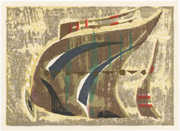
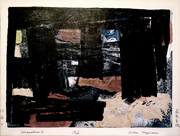
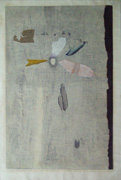
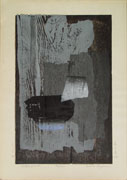
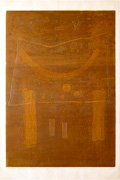
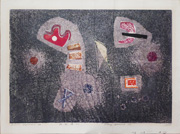
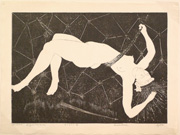
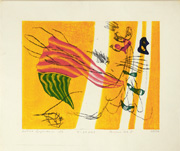
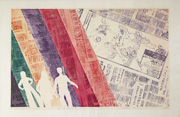
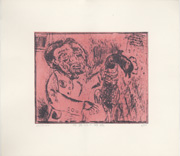
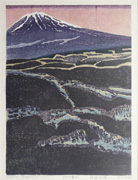

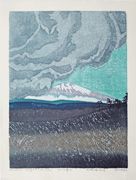
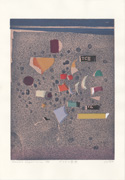
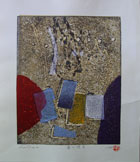
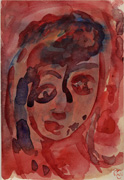
-1962-200px-web.jpg) Fantasy in Red, 1962
Fantasy in Red, 1962